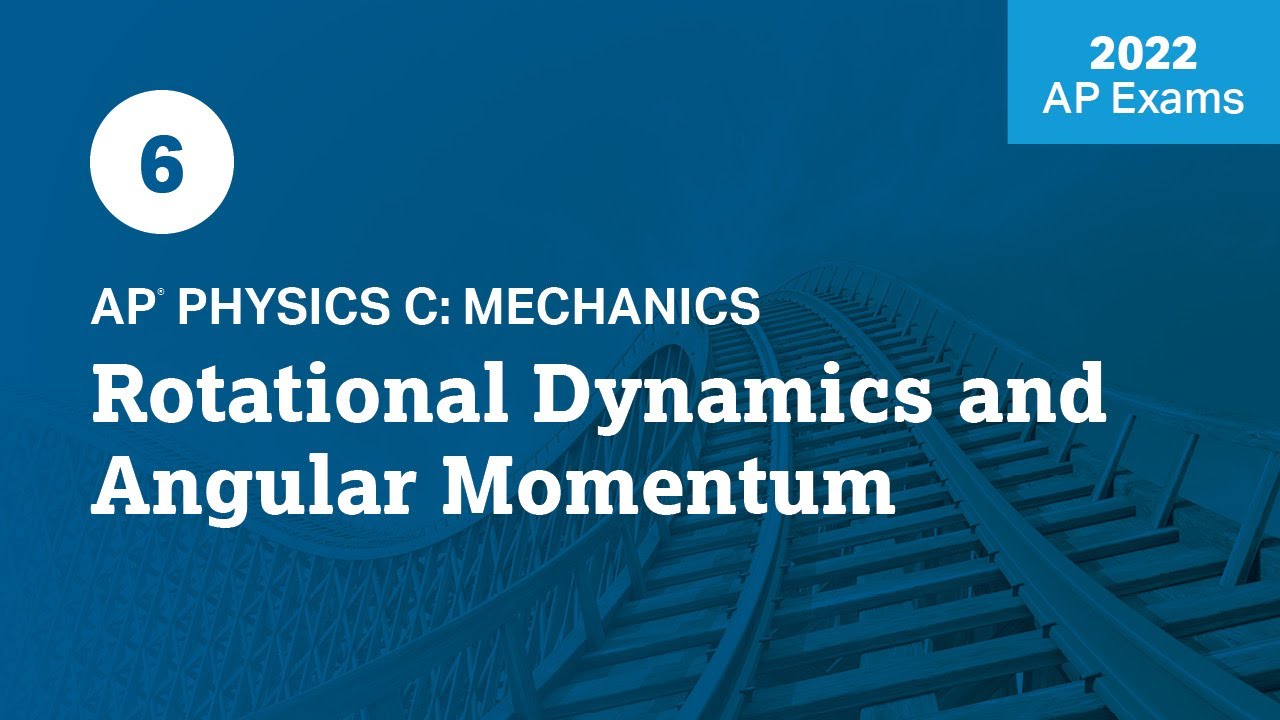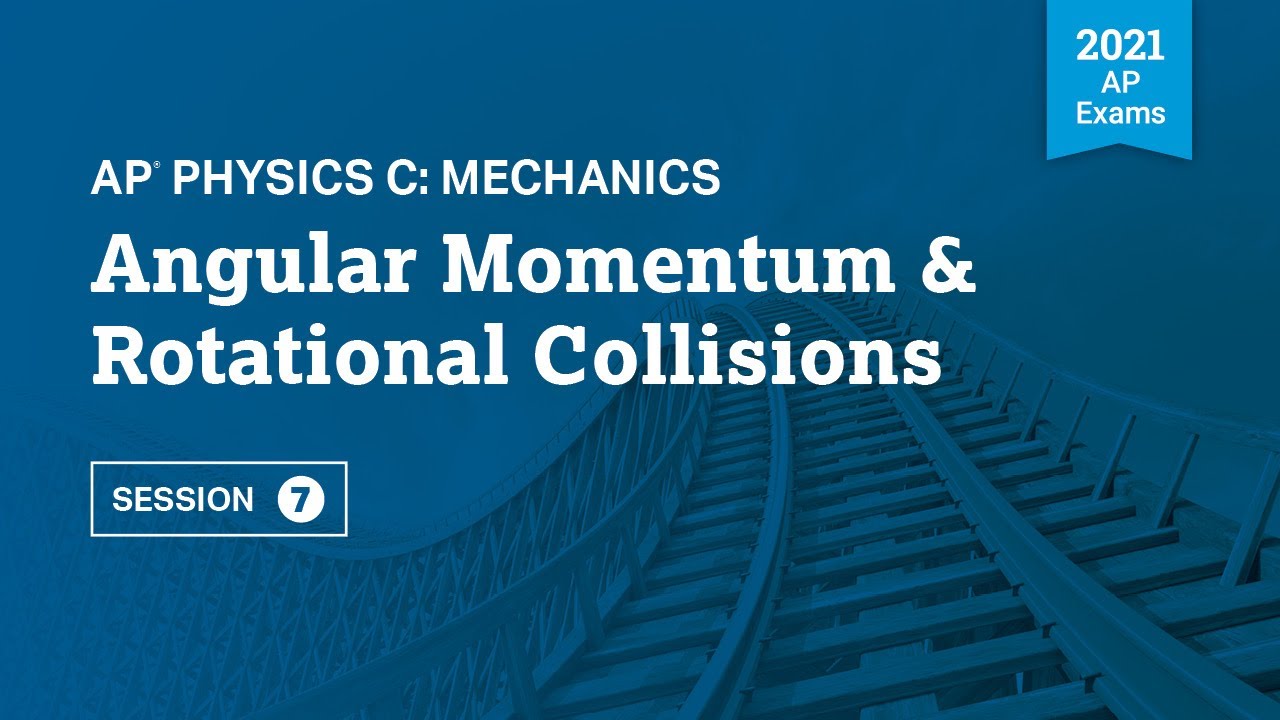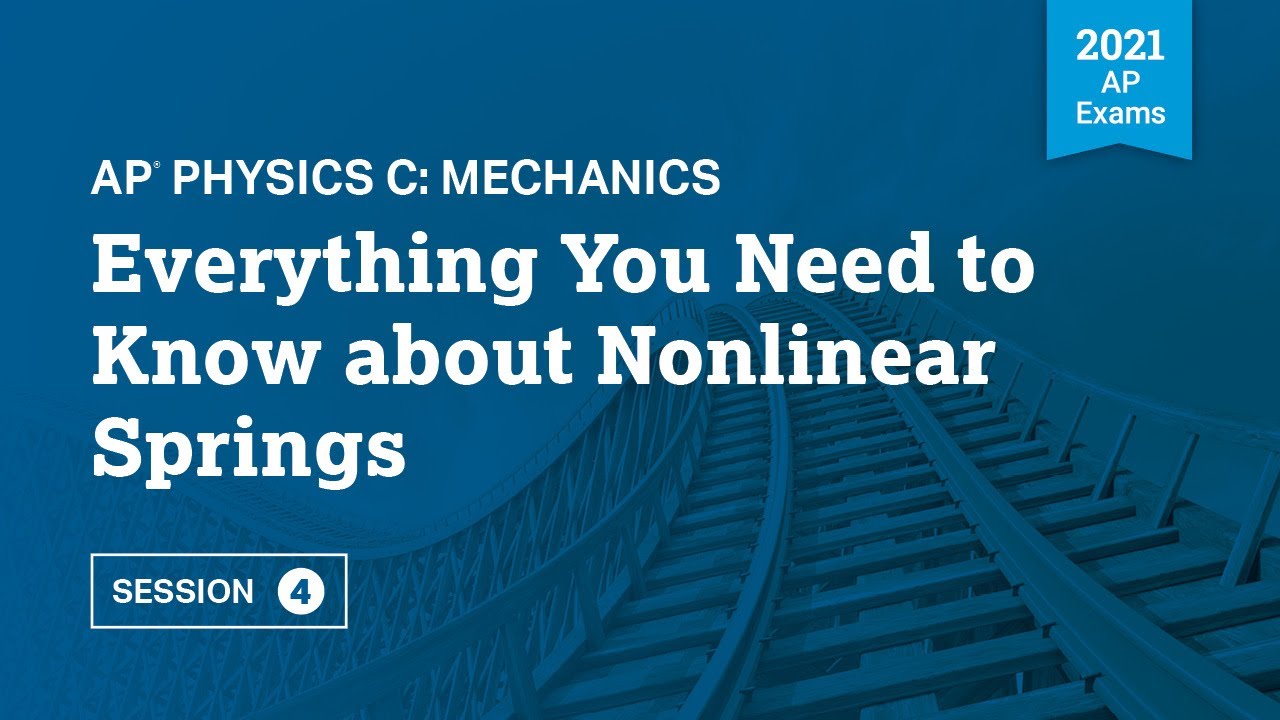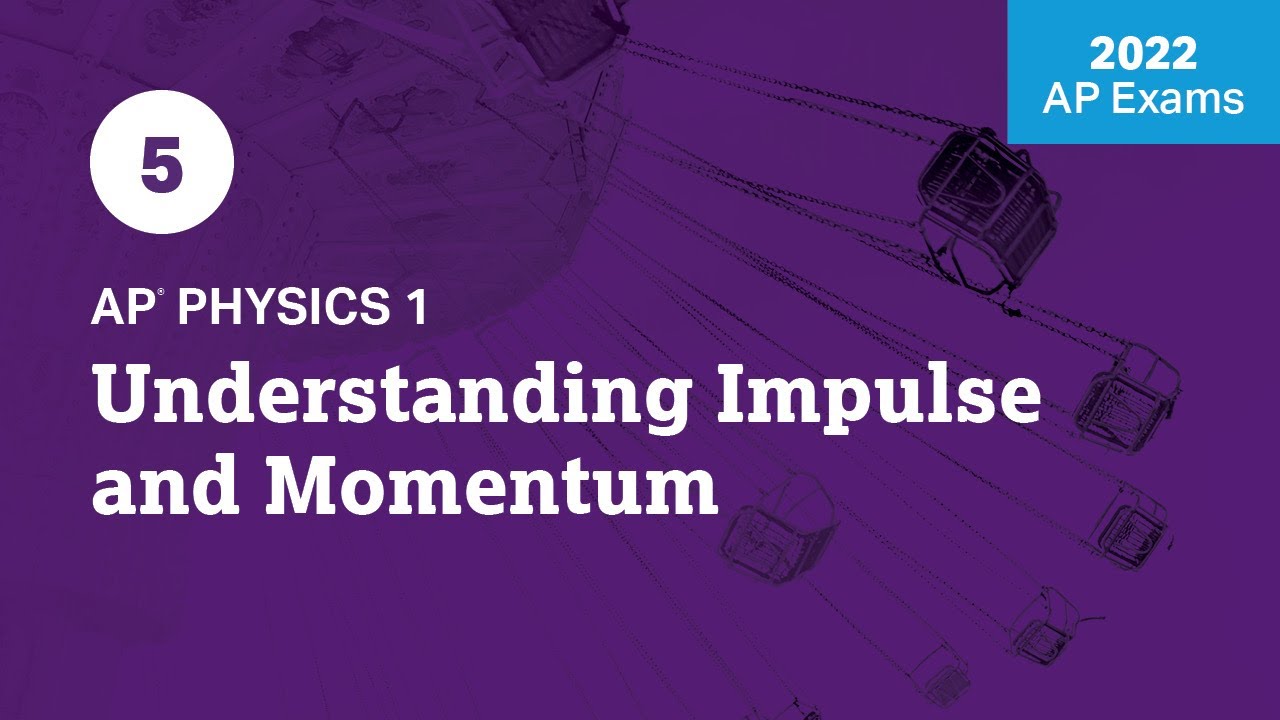2022 Live Review 4 | AP Physics C: Mechanics | System of Particles and Linear Momentum
TLDRIn this AP Physics C Mechanics live review, instructor Julie Hood from Mast Academy High School in Miami, Florida, covers fundamental concepts of linear momentum and impulse. She explores the relationship between mass, velocity, and momentum, and delves into force quantities and velocity changes during collisions. Hood uses multiple-choice and free-response questions from past AP exams to illustrate problem-solving strategies. She emphasizes the importance of understanding momentum conservation in various scenarios, including explosions and collisions, and encourages students to practice with resources from the College Board and AP Classroom.
Takeaways
- 📚 The session focuses on linear momentum and impulse, exploring the relationships between mass, velocity, and momentum of moving objects.
- 🔍 The importance of considering the quantities of force and the time over which collisions happen is emphasized, as they relate to changes in velocity and momentum.
- 📉 The session discusses the use of force versus time graphs to understand changes in momentum and introduces non-linear functions relevant to AP Physics C.
- 🚗 An example is given involving a truck and a car to illustrate concepts of kinetic energy and momentum during a race scenario.
- 📝 The instructor suggests using resources like AP Central and the College Board website for practice questions and scoring rubrics to prepare for the exam.
- 🔄 The principle of conservation of momentum is highlighted, noting that momentum can only change when an external force is applied, known as impulse.
- 📚 The concept of work done on a vehicle being equal to the change in kinetic energy (force times distance) is explained.
- 🔢 The session includes problem-solving techniques for determining the change in momentum when the force and time of application are known.
- 📈 The use of calculus for finding changes in momentum when force is a non-linear function of time is introduced.
- 💡 The instructor stresses the importance of understanding vector operations in physics, as momentum, velocity, and forces are vector quantities.
- 🎯 The session concludes with an emphasis on practicing problems from past exams and understanding the expectations for the AP Physics C Mechanics exam.
Q & A
What is the main topic of the video?
-The main topic of the video is linear momentum and impulse in the context of AP Physics C Mechanics.
Who is the presenter of the video?
-The presenter of the video is Julie Hood from Mast Academy High School in Miami, Florida.
What are the key concepts covered in the video?
-The key concepts covered include relationships between mass and velocity, momentum of moving objects, quantities of force over time, changes in momentum, and kinetic energy changes.
How does the video approach the teaching of momentum?
-The video teaches momentum through the concept of conservation, impulse as an external force, and its relation to kinetic energy and collisions.
What is the significance of the truck and car race scenario in the video?
-The truck and car race scenario illustrates the concepts of kinetic energy and momentum, showing how they can differ even when two vehicles experience the same force over time.
What is the role of impulse in the context of momentum?
-Impulse is the change in momentum that occurs when an external force is applied over a period of time, and it is represented by the symbol 'J' or 'Δp'.
How can one find the total change in momentum for a variable force over time?
-The total change in momentum can be found by integrating the force function over time or, in simpler cases, by calculating the area under the force-time graph.
What is the importance of considering the direction of vectors in momentum problems?
-Considering the direction of vectors is crucial because momentum, velocity, and forces are vector quantities, and their directions must be accounted for in calculations, especially in collisions and impulse problems.
How does the video use the example of a cannon and cart to explain conservation of momentum?
-The cannon and cart example demonstrates that when the cannon fires a projectile, the system's total momentum is conserved. The cart comes to rest, and the projectile continues with the calculated velocity, showing the conservation of momentum.
What is the purpose of practicing old AP exam questions and using scoring rubrics?
-Practicing old AP exam questions and using scoring rubrics helps students understand the exam format, what is expected of them, and how to approach different types of problems for better performance.
How does the video address the concept of kinetic energy in collisions?
-The video explains that while momentum is always conserved in collisions, kinetic energy may not be. It demonstrates this through examples where the total kinetic energy before and after a collision may differ.
What is the significance of the pendulum and dart experiment in the video?
-The pendulum and dart experiment illustrates the principles of conservation of momentum and energy in a real-world scenario, showing how the mass of the dart affects the outcome of the collision and the subsequent motion.
Outlines
📚 Introduction to AP Physics C Mechanics Review
Julie Hood from Mast Academy High School introduces the AP Physics C Mechanics live review session, focusing on linear momentum and impulse. The session will cover the relationship between mass, velocity, and momentum, the role of force over time in collisions, and changes in momentum and kinetic energy. Julie suggests using resources from the College Board's website for practice, emphasizing the importance of understanding expectations for the exam. She introduces the concept of momentum as a conserved vector quantity and the impact of external forces on it.
🚚 Kinetic Energy and Momentum in Vehicle Dynamics
The script explores a scenario involving a truck and a car with identical engines, discussing kinetic energy and momentum. It explains that despite different finishing times in a race, both vehicles end with the same kinetic energy due to the same work done by the constant force. However, the truck, taking longer to finish, has more momentum due to the time factor in momentum change calculations. The script also considers the kinetic energy and momentum during the race, concluding that the smaller car has more kinetic energy mid-race due to its higher velocity.
📘 Collisions and Conservation of Momentum
This section delves into collision problems, using the conservation of momentum principle. It presents a problem where two discs of different masses and velocities collide and stick together, resulting in a composite body with a velocity that can be calculated using conservation of momentum. Another example involves a cannon firing a projectile, which comes to rest while the projectile continues moving, illustrating the application of conservation of momentum in determining the projectile's velocity.
📊 Force-Time Graphs and Calculating Momentum Changes
The script explains how to use force-time graphs to calculate changes in momentum, emphasizing the integral of force over time as the area under the curve. It provides an example where a variable force acts on an object, and the total change in momentum is found by adding the areas of rectangles under the graph, resulting in a net change of zero. The section also touches on using calculus for non-linear force functions to find momentum changes.
🔍 Vector Analysis in Momentum Problems
This part of the script discusses the vector nature of momentum, emphasizing the importance of direction in momentum calculations. It presents a problem involving a collision and the subsequent vector addition of momenta to determine the correct set of vectors representing the momenta after the collision. The script also addresses a scenario where a ball collides with the floor and rebounds, explaining how to determine the impulse exerted by the floor using vector subtraction.
💥 Exploding Systems and Momentum Conservation
The script introduces the concept of explosions as a type of problem where internal forces are involved, and momentum is conserved despite the system's internal changes. It presents a problem involving a mass that explodes into two pieces with specific mass ratios and velocity changes, using algebra to find the velocity of the resulting pieces. Another problem involves a projectile that explodes at its highest point, with one piece falling straight down and the other moving horizontally, illustrating the application of conservation of momentum in two dimensions.
📐 Projectile Motion and Collision Analysis
This section focuses on projectile motion and collision analysis, starting with a dart launched at an angle that collides with a hanging block at the peak of its trajectory. The collision is inelastic, and the script explains how to use conservation of momentum to find the velocity of the combined dart-block system. It then calculates the height reached by the system using energy conservation and explores the effect of a more massive dart on the collision outcome and the period of oscillation.
🔚 Conclusion and Final Thoughts on Momentum
The final paragraph wraps up the session by summarizing key points about linear momentum, impulse, and their applications in various problems, including explosions and collisions. It emphasizes the importance of understanding momentum conservation and the impact of external forces. The script encourages students to review past exams, free response questions, and scoring rubrics for deeper understanding and to prepare for the upcoming review on torque and rotational kinematics.
Mindmap
Keywords
💡Linear Momentum
💡Impulse
💡Kinetic Energy
💡Velocity
💡Force
💡Collision
💡Conservation of Momentum
💡Explosions
💡Projectile Motion
💡Work
💡Free Response Questions
Highlights
Introduction to the AP Physics C Mechanics review session by Julie Hood, focusing on linear momentum and impulse.
Exploration of the relationship between mass, velocity, and momentum, and the impact of force and time on collisions.
Discussion on the change in momentum using force versus time graphs and the introduction of non-linear functions in AP Physics C.
Julie Hood's suggestion to use AP Central and Google for accessing old AP exams and practice materials.
Explanation of momentum as a conserved vector quantity and the concept of impulse as a change in momentum.
Thought experiment involving a truck and a car to illustrate the principles of kinetic energy and momentum.
Analysis of the kinetic energy and momentum during different stages of a race between a truck and a car.
Example problem from a 1993 AP exam about determining the change in momentum given force and time.
Solution to a problem involving two colliding discs and the application of conservation of momentum.
Illustration of a cannon and cart problem to demonstrate the use of conservation of momentum in a real-world scenario.
Practice problem involving a graph of force over time and the calculation of total change in momentum.
Introduction to the concept of impulse as the integral of force over time and its relation to change in momentum.
Calculation of the speed of an object after being propelled by a force that varies with time.
Derivation of force from a given momentum function using calculus, demonstrating the relationship between force and momentum.
Vector addition of momenta and the importance of direction in momentum conservation problems.
Analysis of a collision involving a ball and the floor to determine the impulse exerted by the floor.
Problem involving two pucks on an air table and the calculation of total kinetic energy and momentum before and after a collision.
Exploration of explosions as a special case of momentum conservation where internal forces are considered.
Solution to a projectile motion problem involving an exploding object and the application of kinematics equations.
Practice with a free response question from the 2001 AP exam involving a motion and force sensor recording a cart's collision.
Calculation of average acceleration, change in momentum, mass of the cart, and energy lost in a collision using experimental data.
Final thoughts and recommendations for reviewing past exams, AP Classroom resources, and upcoming review topics on torque and rotational kinematics.
Transcripts
Browse More Related Video

1 | MCQ | Practice Sessions | AP Physics C: Mechanics

2022 Live Review 6 | AP Physics C: Mechanics | Rotational Dynamics and Angular Momentum

2021 Live Review 7 | AP Physics C: Mechanics | Angular Momentum & Rotational Collisions

2021 Live Review 4 | AP Physics C: Mechanics | Everything You Need to Know about Nonlinear Springs

AP Physics Workbook 7.I Collisions "Old and Lack Full Explanation"

2022 Live Review 5 | AP Physics 1 | Understanding Impulse and Momentum
5.0 / 5 (0 votes)
Thanks for rating: